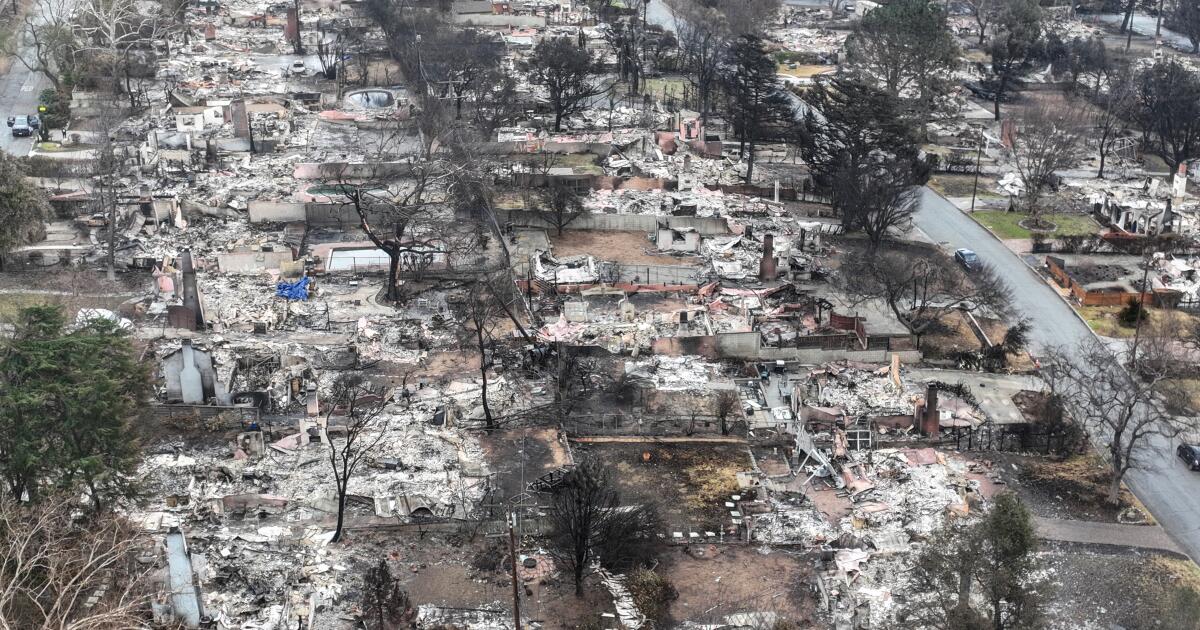World
Family Sues Genasys After Fatality in Eaton Fire Incident

Attorneys for the family of Stacey Darden, a resident of Altadena who tragically lost her life in the Eaton fire, filed a wrongful death lawsuit on January 8, 2024. The lawsuit claims that the emergency alert software used by Los Angeles County was defective and failed to notify Darden in a timely manner, preventing her from evacuating the area before it was engulfed by flames.
The complaint, submitted more than ten months after the devastating incident, specifically targets Genasys, the company responsible for the emergency alert system. It contends that the software’s predesigned evacuation zones, referred to as “polygons,” resulted in significant delays for residents east of Lake Avenue in receiving evacuation orders on the night of the fire. While the lawsuit also implicates Southern California Edison for allegedly sparking the fire with its equipment, this is one of the first cases to highlight the shortcomings of the evacuation notifications.
Geraldine “Gerry” Darden, Stacey’s sister, expressed the family’s anguish over the decision to pursue legal action against Genasys. “Edison started this fire, and Genasys never warned her that she was in danger,” she stated. “My sister was studiously following the evacuation orders the night of the Eaton fire. The truth is that if these companies had done what they were supposed to do, Stacey would be alive today.”
The Eaton fire ignited on January 7, 2023, under extreme red flag conditions that led to multiple fires across the region, from the Santa Monica Mountains to the San Gabriel Mountains. As flames spread near Eaton Canyon around 18:30, strong winds carried embers across the landscape, resulting in the destruction of thousands of homes and the deaths of nineteen individuals in Altadena.
In the aftermath of the fire, reports revealed that residents living west of Lake Avenue did not receive electronic evacuation notifications until hours after the flames began spreading. Most of the fatalities occurred in this area, where alerts were issued only around 03:30 on January 8, significantly later than those received by residents on the east side of Lake Avenue.
At a news conference in Altadena, attorney Doug Boxer highlighted the urgency of the situation, stating that Stacey Darden, aged 54, and her sister were closely monitoring news updates regarding evacuation zones as the fire approached. Darden’s home, located at 2528 Marengo Ave., was not included in any evacuation order zone, according to Boxer. The family claims that the first evacuation alert sent to Darden’s phone arrived at 05:43 on January 8, after her last recorded cellphone activity around 03:30.
“By the time an evacuation order was finally pushed to her phone, it was too late,” said attorney Mikal Watts. He characterized the situation as “a tragedy of corporate failures,” illustrating the broader implications of emergency alert systems. He further described the incident as “digital redlining,” referencing the historical inequities affecting the west side of Altadena, which is predominantly marginalized.
The lawsuit seeks clarity on why alerts to residents west of Lake Avenue were delayed, a question that both Genasys and county officials have yet to answer satisfactorily. In the wake of the Eaton fire, numerous neighborhood groups have voiced their concerns over the late alerts, urging county officials to provide explanations for the disparity in notification times between different areas.
The complaint alleges that Genasys had a contractual obligation to deliver a mass notification system that was “safe in its operation for its intended purpose” and “free of defects in its design and manufacture.” It argues that the software’s predefined evacuation zones were “defective and unreasonably dangerous,” especially as they did not account for vulnerable populations, including the elderly, who may require additional time to evacuate.
A recent state report has drawn attention to the challenges faced by senior facilities during the emergency, revealing that some operators struggled to evacuate all residents in time. As discussions around accountability for the Eaton fire continue, officials from Genasys have maintained that their software functioned as intended during the incident. In a March meeting, Richard Danforth, CEO of Genasys, stated, “the system was up and operational.”
A county-supported after-action report from the McChrystal Group suggested that the majority of alert issues stemmed from human error, rather than technological failures. At the time of the fire, Genasys’ software was relatively new to Los Angeles County, and only a limited number of emergency management personnel had received training on its use before the incident unfolded.
The ongoing legal action reflects broader concerns regarding emergency preparedness and communication in vulnerable communities, raising urgent questions about the responsibilities of companies and government agencies in crisis situations.
-

 Top Stories1 month ago
Top Stories1 month agoNew ‘Star Trek: Voyager’ Game Demo Released, Players Test Limits
-

 World1 month ago
World1 month agoGlobal Air Forces Ranked by Annual Defense Budgets in 2025
-

 World1 month ago
World1 month agoMass Production of F-35 Fighter Jet Drives Down Costs
-

 World1 month ago
World1 month agoElectrification Challenges Demand Advanced Multiphysics Modeling
-

 Science1 month ago
Science1 month agoTime Crystals Revolutionize Quantum Computing Potential
-

 Business1 month ago
Business1 month agoGold Investment Surge: Top Mutual Funds and ETF Alternatives
-

 Top Stories1 month ago
Top Stories1 month agoDirecTV to Launch AI-Driven Ads with User Likenesses in 2026
-

 Entertainment1 month ago
Entertainment1 month agoFreeport Art Gallery Transforms Waste into Creative Masterpieces
-

 Lifestyle1 month ago
Lifestyle1 month agoDiscover Reese Witherspoon’s Chic Dining Room Style for Under $25
-

 Health1 month ago
Health1 month agoGavin Newsom Critiques Trump’s Health and National Guard Plans
-

 Lifestyle1 month ago
Lifestyle1 month agoLia Thomas Honored with ‘Voice of Inspiration’ Award at Dodgers Event
-

 Business1 month ago
Business1 month agoUS Government Denies Coal Lease Bid, Impacting Industry Revival Efforts








